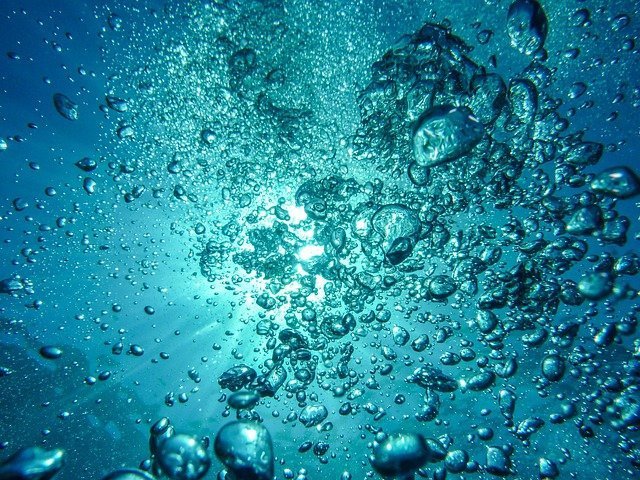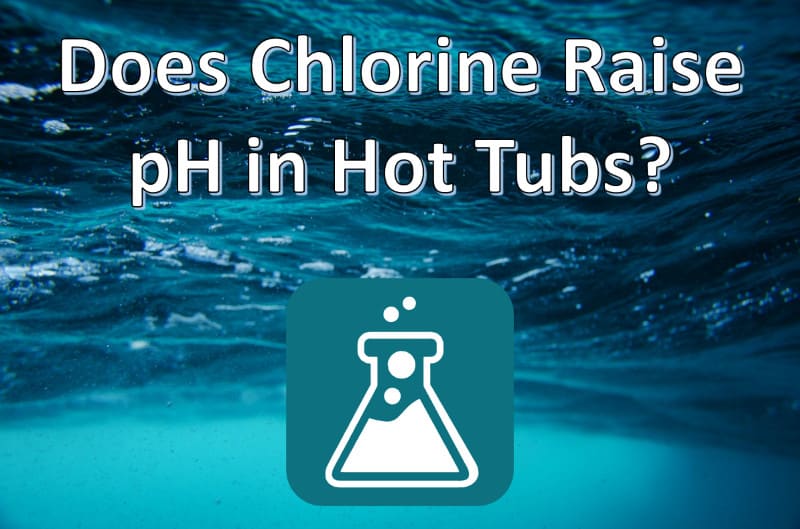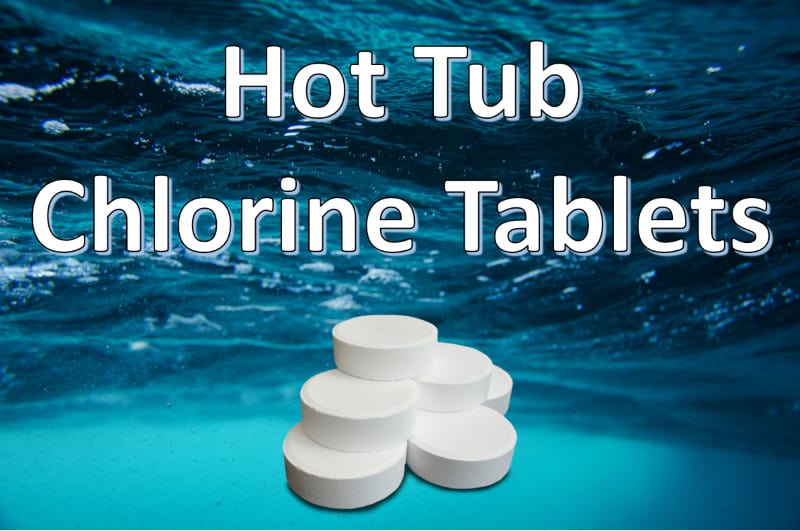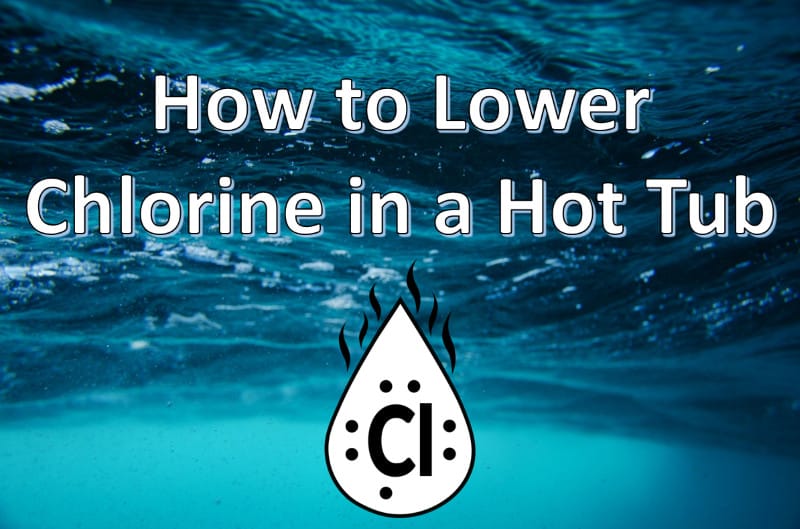Does chlorine raise pH in a hot tub?
pH levels in hot tubs should be between 7.2 and 7.8. In most cases, adding chlorine to the swimming pool or hot tub water will lower pH levels. However, there are some cases where adding chlorine can raise pH levels. If you’re concerned about pH levels in your pool or hot tub, it’s essential to test the water regularly and take corrective action as needed.
Stop wasting time and money with hot tub maintenance and confusing water chemistry! The Hot Tub Handbook and Video Course will help keep your hot tub balanced, sanitized, and crystal clear all the time.
Check out my list of high-quality hot tub products to help keep your hot tub clean and running great all year long!
My recommended product to help you test your hot tub or pool water for accurate pH, alkalinity, bromine, and chlorine readings is the AquaCheck Trutest Digital Reader.
One of the most common concerns about swimming and hot tubs is whether the chlorine in the water will raise pH levels.
pH is a measure of how acidic or alkaline a substance is, and it can have a significant impact on water quality.
Chlorine is a powerful chemical that can reduce the pH level of water in hot tubs. Therefore, it’s important always to add chemicals slowly and carefully, wait 20 minutes before testing again.
This is essential as not to risk affecting its natural alkalinity levels too drastically (or worse yet, having an adverse reaction), then check back often with your test kit until it reads consistent readings across multiple tests for safety purposes!
So does chlorine raise pH in a hot tub? In this article, I will talk more about it.
Let’s get started!
Does Chlorine Raise pH in a Hot Tub?
Hot tubs are often at a pH level of 7.2 – 7.8. Adding chlorine will increase this number slightly, but because the chemical also reacts to form hypochlorous acid, which reduces acids and makes your hot water less acidic, there’s no change unless large amounts of chlorine are added.
Chlorine is great for disinfecting your hot tub, but it can imbalance the water if used too much. High levels of chlorine produce excess hypochlorous acid, reducing pH and raising alkalinity.
Never use it to adjust pH because other chemicals can be used for this purpose instead.
If you have a hot tub, the ideal chlorine level should be between 3 and 5 parts per million (ppm).
To maintain optimal sanitization for your swimmer’s safety and enjoyment of their stay in contact with water, aim to add about 2/4 ounce or three teaspoons every two days. If this consistency is too much work, then consider using tablets instead.
Chlorine tablets come in measured doses that will dissolve over time, so all one needs to do is place them into the hot tub with a chlorine dispenser!
My recommended choice for hot tub Chlorine Tablets. These tablets come in different-sized containers based on weight.
My recommended choice for a hot tub chlorine tablet dispenser is this U.S. Pool Supply dispenser.
Does Chlorine Affect pH?
If the pH level rises above 7.8, then chlorine becomes less effective. This is because chlorine is a chemical that kills bacteria and other organisms by destroying protein structures. It needs to first break apart into ions in water to do this. When the pH level of the water exceeds 7.8, it becomes difficult for chlorine to complete this process.
This means that there will be more bacteria and other organisms living in your hot tub water than there should be if you have a pH level of 7.8 or higher.
The pH of your hot tub water is crucial because it affects the rate at which corrosion occurs. Corrosion can affect metal piping, equipment, and concrete in hot tubs. However, if you want to avoid any adverse effects on these items, ensure there’s not too much chlorine present!
Chlorine is a chemical that can affect pH because it reacts with water to form hydrochloric acid. If chlorine is at a high level in your hot tub, this chemical will cause a reduction in pH and increase alkalinity. This occurs when chlorine combines with the water to form hydrochloric acid (HCL).
This chemical can eliminate the number of bacteria found in your pool or hot tub. It can also oxidize many foreign substances, which is effective for disinfecting pools and hot tubs.
One concern about adding chlorine to the water is that you may end up changing its pH level, but it’s essential not to use too much of this chemical if you can.

Stop wasting time and money with hot tub maintenance and confusing water chemistry! Get Instant access to this easy-to-use book and video course so you can spend less time cleaning and more time soaking.
Learn MoreWhat Causes Hot Tub pH To Go Up?
When pH rises above 7.8, it becomes more basic (alkaline). Hot tubs generate a lot of bubbles and have high temperatures, which creates carbon dioxide very quickly. This is the primary reason why hot tub owners need to add something to lower their pH and alkalinity levels. Other problems such as local water sources, too much bacteria, and not enough chlorine will cause pH imbalances in your spa.
Another reason your hot tub water will test high on pH levels is the availability of higher-than-normal pH levels in your local water source. Therefore, you should test your local water source for pH levels before adding it to your hot tub to ensure that it is balanced.
If this is not the case, lower its acidity to the recommended levels by adding appropriate compounds. The pH could also rise above the required range if you added a little too much of the pH increase when your hot tub’s pH tested low.
There are a few different things that can cause the pH level in your hot tub to go up.
One of the most common causes is a build-up of organic matter. This can include body oils, sweat, and dirt. If this build-up isn’t cleaned regularly, it can cause the pH level to increase.
Another common cause of high pH levels in hot tubs is a lack of chlorine. If there’s not enough chlorine in the water, it can allow bacteria to grow. This bacteria will raise the pH level of the water.
Finally, high pH levels can also be caused by a high alkalinity level in the water.
Alkalinity is a measure of how many bases are present in the water. It can be controlled by adding acid to the water.

How to Lower pH in a Hot Tub Quickly?
Muriatic acid and dry acid (sodium bisulfate) are two main chemicals typically used to decrease pH in hot tubs. Although they do the same thing, pay attention to which chemical I being added and how much. An acidic compound with low pH will be highly suitable in scaling down the alkalinity levels. Differing methods can lead you to add too much or not enough.
If your pH level is high, the best way to lower it is by adding acid. One of the most common things people use to lower pH levels is a pool shock. Shock usually includes acid and other chemical compounds that will decrease the pH level.
A pool shock can also be used for other reasons, but it’s essential not to use these chemicals too often or in a large amount. Other chemical compounds added to lower pH include soda ash, muriatic acid, and borax for hot tubs.
In general, if you’re using a chlorine bleach product, then you should dilute it with water before adding it to your hot tub.
If you’re using products containing sodium hypochlorite, make sure to dilute it with water before adding it to your hot tub.
I recommend Hot Tub Things pH and Alkalinity Down to help lower the pH in your hot tub.
How to Raise pH in a Hot Tub Naturally?
If pH in your hot tub goes below 7.2, there are two main ways to raise the pH level in a hot tub. The first way is to use chemicals called pH increase. Add one cap of the pH increaser, let the hot tub mix for a couple of hours, and test the water again. Soda ash is used as a quick solution to raise pH. The second way is to add fresh water to the spa.
There are a few ways to raise the pH level in your hot tub naturally.
One way is by using soda ash. This will increase the alkalinity of the water and will also raise the pH level.
Another way to raise the pH level is by using baking soda. Baking soda will also increase the alkalinity of the water, but it won’t raise the pH as much as soda ash.
The final way to raise the pH level is by using calcium chloride. This will also increase the alkalinity of the water, but it will not raise the pH level as much as baking soda or soda ash.
If you’re using any of these methods, ensure that you follow the instructions to avoid over-correcting the pH level.
Ideal pH Range For Hot Tubs: 7.2 – 7. 8
The ideal pH range for your hot tub should always be in the range of 7.2 – 7.8. I recommend testing the pH regularly, usually twice a week with test strips or a test kit to ensure it is within the desirable range. You may also establish the accuracy of your test results by taking a sample of your hot tub water to your local dealer for testing.
Does pH Minus Reduce Chlorine Levels?
No. pH reducers are designed to lower the pH level of your hot tub water with pH-neutral chemicals. Adding acidity does not change chlorine levels. However, when pH is over 7.8, chlorine becomes less effective. By lowering pH to normal levels, chlorine does become more effective.
Acidic compounds have low pH, meaning they will be highly suitable in scaling down the alkalinity levels. However, differing methods can lead you to add too much or not enough.
If your pH level is high, the best way to lower it is by adding acidity (e.g., pool shock). You can also use muriatic acid or dry acid (sodium bisulfate) to decrease pH in hot tubs.
What Happens If You Put Too Much Chlorine in a Hot Tub?
If you put too much chlorine in a hot tub, it can cause several problems. The most common issues are eye irritation, skin irritation, and respiratory problems. It can also cause the pH level to become too high, which can harm your health.
If you add too much chlorine to your hot tub, you could experience several adverse effects. These can include:
Skin Irritation
If you add too much chlorine to your hot tub, you could experience skin irritation. This is because chlorine is a harsh chemical that can cause your skin to become dry and itchy.
Eye Irritation
If you add too much chlorine to your hot tub, you could experience eye irritation. This is because chlorine can get into your eyes and cause them to water.
Sore Throat
Chlorine can also cause sore throat from inhaling or swallowing chlorine vapors. Chlorine vapors are released when the chemical combines with water and is dissolved in the hot tub. If you continue to ingest high chlorine levels, it could be harmful and lead to permanent injury.
Damage to the Pumps and Filters
Adding too much chlorine to your hot tub could damage the filters and other components. This is because too much chlorine will lead to a corrosive bleaching effect. When this happens, it may also cause corrosion on metal elements in the system.
To avoid this problem, ensure that you don’t exceed the recommended dosage for chlorine in a hot tub or spa. This is usually one teaspoon of chlorine per 10 gallons of water.
What Happens If The pH Level is Too High in a Hot Tub?
It is important to maintain the pH level in your hot tub at a safe range so that it will last longer. High alkaline levels can lead to scale build-up on surfaces, which are abrasive and damage the acrylic plastic panels over time. This also damages filters by blocking them with deposits from calcium build-up and white flakes getting caught inside jets due to low circulation flow rate.
The effects of high pH levels in a hot tub could extend to both the heater surfaces and plumbing, where scales may form. The blockage can happen either here or on one component affecting normal functioning.
Will Adding Bromine Lower pH in a Hot Tub?
No, adding bromine will not lower pH in a hot tub. Bromine is a sanitizer that works by killing bacteria and viruses. It does not affect the pH level of the water.
Despite the popularity of chlorine, bromine is more effective at sanitizing your hot tub because it’s so much less volatile than chlorine. However, the chemical reaction can give off toxic fumes if you mix them up!
I recommend these bromine tablets for your spa!
Consider Using a Water Care Monitor
Monitoring the health of your hot tub can often be challenging if you are not testing the water on a regular basis. This can also be a problem if you go on holiday or you are unable to take care of your hot tub due to mobility issues.
A test system I highly recommend is the Exact Industrial Test System. This system is great for hot tubs and pools and gives your a highly accurate digital readout of your water chemistry compared to other methods.
The pHin Smart Water Care Monitor for pools, hot tubs, and inflatable spas continuously tests the water and alerts you when to add chemicals with the integrated mobile app.
This water care monitor also takes constant readings of the temperature inside your hot tub. This will give you peace of mind while away from your spa.
The mobile app will inform you when to add chemicals such as chlorine, and how much chemical is recommended. This is done by entering your hot tub or pool’s unique dimensions.
This mobile app is great if you’re wondering “does chlorine raise pH in a hot tub?” sometimes it’s not always clear.
Simply scan the bar code of any chemical brand and the pHin app will calculate how much chemical is to be added to the water. Most products and brands are recognized by the application.
The pHin device will sample water more than 1000 times per week to give you an accurate reading compared to using test strips.
The pHin device works with different water types including chlorine, bromine, and saltwater hot tubs, swim spas, inflatable hot tubs, and pools.
This unique device comes with a lifetime warranty to ensure your water remains clear and ready for you to use at all times.
Does chlorine Raise pH in a Hot Tub: Conclusion

In this article, I’ve talked a lot about pH and chlorine.
Chlorine is a sanitizer that kills bacteria. It doesn’t have a direct effect on pH. However, if too much chlorine is added, it will raise pH levels.
Higher pH levels can cause chlorine to be less effective.
It’s essential to keep your pH levels between 7.2 and 7.8 for best results.
If pH is too high or too low, it will cause problems in your spa.
Bromine is also a great choice as a sanitizer if you have problems with chlorine.
I hope this article on does chlorine raise pH in a hot tub was helpful.
Thanks for visiting spatoolkit.com
James Brockbank

Stop wasting time and money with hot tub maintenance and confusing water chemistry! Get Instant access to this easy-to-use book and video course so you can spend less time cleaning and more time soaking.
Learn More








![Hot Tub Shock: Why It’s Important [#1 Guide]](https://www.spatoolkit.com/wp-content/uploads/2021/02/hot-tub-shock.jpg)
